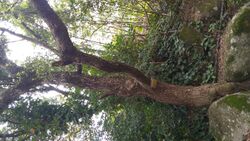Biology:Cinnamomum parthenoxylon
| Cinnamomum parthenoxylon | |
|---|---|

| |
| The trunk of Cinnamomum parthenoxylon, Siu Lek Yuen Green Trail, Sha Tin, NT, Hong Kong | |
| Scientific classification | |
| Kingdom: | Plantae |
| Clade: | Tracheophytes |
| Clade: | Angiosperms |
| Clade: | Magnoliids |
| Order: | Laurales |
| Family: | Lauraceae |
| Genus: | Cinnamomum |
| Species: | C. parthenoxylon
|
| Binomial name | |
| Cinnamomum parthenoxylon (Jack) Meisn.[2]
| |
| Synonyms[2] | |
|
Synonymy
| |
Cinnamomum parthenoxylon is an evergreen tree in the genus Cinnamomum, 10–20 m (33–66 ft) tall. It is native to South and East Asia (Bhutan, Myanmar, Cambodia, China , India , Indonesia, Laos, Malaysia, Nepal, Philippines , Thailand, and Vietnam).[3]
In English, C. parthenoxylon is known as Selasian wood,[4] saffrol laurel,[5] or Martaban camphor wood.[6] It has the outdated heterotypic synonym Laurus porrecta (Roxb.). The species name parthenoxylon derives from parthenos xylon (Greek: παρθενός ξύλον), meaning "virgin wood". The common name in Spanish is alcanforero amarillo[7] ("yellow camphor") and it is thought to be the tree known as Khmer: ម្រះព្រៅភ្នំ (mreah prew phnom).
Description
Cinnamomum parthenoxylon is an evergreen tree, which grows up to 50 metres tall.[1][8] with a trunk to 60 cm in diameter.[8] The tree has gray to brown bark. Its leaves are glossy green ovals 7–10 cm long with a point at the end. Like many plants in the Lauraceae, the leaves give off a pleasant smell when crushed. The flowers appear in clusters and are green and very small. The fruits are blackish drupes.[9]
Range and habitat
Cinnamomum parthenoxylon ranges from Nepal and the eastern Himalayas through Assam, Indochina, southern China, Hainan, Peninsular Malaysia, Sumatra, Java, Borneo, and the Lesser Sunda Islands.[2] The species' estimated extent of occurrence (EOO) is very large at 8,025,973 km2, and its estimated area of occupancy (AOO) is 520 km2.[1]
It grows in primary and secondary lowland and montane tropical and subtropical humid forests, from sea level to 2,000 metres elevation. It can grow on sand, sandstone, or granite substrates.[1]
In Borneo it is found in Sarawak (Kuching and Lundu districts), Sabah (Keningau, Kota Belud, Lahad Datu, Pensiangan, Ranau, Sandakan, Tambunan, Tawau, and Tenom districts), and East Kalimantan, where it grows in lowland and montane rain forest to 2000 metres elevation, and is often found in secondary vegetation.[8]
Uses
The aromatic bark of the plant is used for flavoring, not unlike many other Cinnamomum species.[10]
The tree is of special concern, as it is being harvested at a high rate to obtain safrole, a precursor to the pesticide synergist piperonyl butoxide, the flavorant and fragrance piperonal, and the psychoactive drug MDMA. Much of this illicit harvesting is happening in the Cardamom Mountains and Botum Sakor National Park in Cambodia at the moment.[11][12] The documentary film "Forest of ecstasy" (Vanguard 2009) is investigating the issue on location.[13][14]
An extract from the bark has been shown in rats to reduce postprandial hyperglycemia.[15]
In Indonesia, the flowers of C. parthenoxylon symbolize love and connection between the living and the dead. Traditionally, in the Kudus Regency on the island of Java, the flowers were scattered on tombs by family members.[16]
Conservation
In 2004, the Cambodian government classified C. parthenoxylon as a rare species and prohibited any logging of this tree. In addition, the production, import, and export of safrole rich oils has been illegal in Cambodia since 2007.[11]
In Vietnam the tree is considered critically endangered.[1]
References
- ↑ 1.0 1.1 1.2 1.3 1.4 de Kok, R. (2020). "Cinnamomum parthenoxylon". IUCN Red List of Threatened Species 2020: e.T33198A2834736. doi:10.2305/IUCN.UK.2020-1.RLTS.T33198A2834736.en. https://www.iucnredlist.org/species/33198/2834736. Retrieved 10 April 2023.
- ↑ 2.0 2.1 2.2 Cinnamomum parthenoxylon (Jack) Meisn. Plants of the World Online. Accessed 10 April 2023.
- ↑ Li, Xi-wen; Li, Jie; van der Werff, Henk, "Cinnamomum parthenoxylon", Flora of China, http://www.efloras.org/florataxon.aspx?flora_id=2&taxon_id=242312976, retrieved 27 March 2013
- ↑ Schimmel (April 1911). Annual Report on Essential Oils, Synthetic Perfumes, &c. p. 43.
- ↑ Coster, B (1993). "Diskettes with commercial Woodnames". Tervuren Xylarium Wood Database. Hoofddorp, Holland. http://www.metafro.be/f48/xylarium/species/SN2793.
- ↑ Kurz, Sulpice (1875). Preliminary report on the forest and other vegetation of Pegu. Calcutta: C.B. Lewis, Baptist Mission Press. pp. xcix. https://archive.org/stream/preliminaryrepor00kurzuoft#page/xcviii/mode/2up/search/parthenoxylon. Retrieved 2019-11-17.
- ↑ Porcher, Michel H. (30 April 2007). "Sorting Cinnamomum names". The University of Melbourne. http://www.plantnames.unimelb.edu.au/Sorting/Cinnamomum.html.
- ↑ 8.0 8.1 8.2 Wuu-Kuang, Soh (2011). Taxonomic revision of Cinnamomum (Lauraceae) in Borneo. Blumea - Biodiversity, Evolution and Biogeography of Plants, Volume 56, Number 3, 2011, pp. 241-264(24). Naturalis Biodiversity Center DOI: https://doi.org/10.3767/000651911X615168
- ↑ Sánchez de Lorenzo-Cáceres, José Manuel. "Cinnamomum parthenoxylon". arbolesornamentales.com. http://www.arbolesornamentales.com/Cinnamomumparthenoxylon.htm.
- ↑ Uphof, Johannes Cornelis Theodorus (1968) (in en). Dictionary of Economic Plants (second ed.). New York, NY: J. Cramer. p. 131. ISBN 9783904144711. OCLC 48693661.
- ↑ 11.0 11.1 "Strengthening the response Against Exploitation of Forestry Resources through Organized Law Enforcement (SAFROLE)". United Nations Office on Drugs and Crime. https://www.unodc.org/southeastasiaandpacific/en/project/cambodia/safrole.html.
- ↑ Campbell, Sam (30 August 2009). "Harvested to make Ecstasy, Cambodia's trees are felled one by one.". GlobalPost. http://www.globalpost.com/dispatch/asia/090812/drugs-ecstasy-cambodia?page=0,0.
- ↑ Adam Yamaguchi; Joanne Shen; Mike Horn Yasu Tsuji, eds. (29 October 2009). "Forest of Ecstasy". Vanguard. Season 3. Episode 3. Current TV. Archived from the original on 13 October 2011. Retrieved 8 July 2011. (Episode is not available. Date: February 2014)
- ↑ Documentary film: Forest of Ecstasy Adam Yamaguchi (reporter). Vanguard 2009. Hosted by Cambodian Information Center
- ↑ Jia, Q; Liu X; Wu X; Wang R; Hu X; Li Y; Huang C. (August 2009). "Hypoglycemic activity of a polyphenolic oligomer-rich extract of Cinnamomum parthenoxylon bark in normal and streptozotocin-induced diabetic rats". Phytomedicine 16 (8): 744–750. doi:10.1016/j.phymed.2008.12.012. PMID 19464860. http://www.phytomedicinejournal.com/article/S0944-7113%2808%2900244-4/abstract. Retrieved 2 September 2009.
- ↑ Hamdani, Sylviana (27 November 2009). "Five-Star Tradition at Le Meridien Hotel in Jakarta". The Jakarta Globe. http://thejakartaglobe.com/city/five-star-tradition-at-le-meridien-hotel-in-jakarta/344079.
Wikidata ☰ Q2629453 entry
 |



